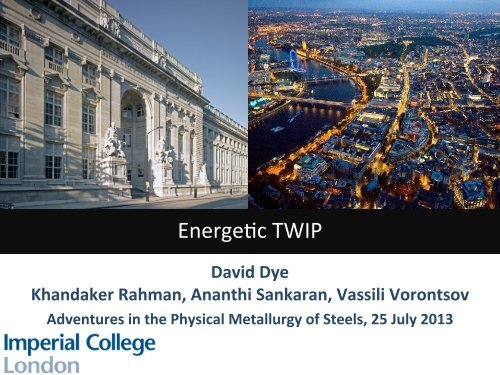Energetic TWIP - Department of Materials Science and Metallurgy
Energetic TWIP - Department of Materials Science and Metallurgy
Energetic TWIP - Department of Materials Science and Metallurgy
Create successful ePaper yourself
Turn your PDF publications into a flip-book with our unique Google optimized e-Paper software.
Energe&c <strong>TWIP</strong>David DyeKh<strong>and</strong>aker Rahman, Ananthi Sankaran, Vassili Vorontsov Adventures in the Physical <strong>Metallurgy</strong> <strong>of</strong> Steels, 25 July 2013
The Problem?High density, high velocity penetrators defeat armour by;“Shear Plugging” - locally imparting so much energy that thematerial comes close to melting, <strong>and</strong> burrowing through, orBehind armour effects such as spall fragments caused by shockwaves on the back side
Armour systemsDisturber - acts to rotate / break <strong>and</strong> spread out theprojectile, maximising its areaAbsorber - absorbs all <strong>of</strong> the energy impartedSpall liner - catches spalled fragmentsAdapted from Thomas EL, Opportunities in protection materials science <strong>and</strong> technology for future army applications.The National Academies Press, 2012.
Absorbing energyChapteFailure occurs onnecking, when thematerial runs out <strong>of</strong>hardening.160014001200Then, any instability<strong>and</strong> stress localises,resulting in failure.True Stress (MPa)1000800600Ultimate Stress,ductility400Yield Stress20000 10 20 30 40 50True Strain (%)
Performance diagram for steels1.4. Thesis Structure 510090LowStrengthHighStrengthAdvanced/UltraHigh Strength80<strong>TWIP</strong>7060*Elongation (%)5040LowcarbonsteelsIFMildIF - HSIS302010CMnTRIPATI-K12 MILDP / CPArmox 370THSLAMIL-DTL-12560MartensiticArmox 440TATI-500 MILATI-600 MILMASTERARM 50000200 400 600 800 1000 1200 1400 1600 1800 2000Tensile Strength (MPa)
How do <strong>TWIP</strong> steels work? 5 µm(b)TD00120 µm101RD111
Repeated twinning= dynamic Hall-Petch (AR, ε=22%)(a)(b) Twin 1 Twin 2111000111(c)0.5 µm(d)Zone Axis: [011]250 nm50 nm
Do they perform in high rate / blast?
(a)The blast centre20 µm
Centre <strong>of</strong> the bulge. Conclusions 1(a)(b)(c)0.5 µm(d)5 nmMaterial from centre <strong>of</strong> blast crater - (a) BF TEM overview, (b) examination <strong>of</strong> internalstructure <strong>of</strong> a selected twin
... into the twin(c)0.5 µm 5 nm(d)(e)2 nm(f)1 nmMaterial from centre <strong>of</strong> blast crater - HREM <strong>of</strong> the twin imaged (down [110]) in (b),showing numerous intrinsic SFs
Fault density near a twin120 nm
analysis, but we acknowledge that the choice <strong>of</strong> function should ultimately be placed on aMeasuring grain sizestheoretically sound foundation, which would be a useful topic for further work based, e.g. onrecrystallisation modelling [173].6050(a)CDFWeibull fitRaw EBSD100806050(b)PDF154040Frequency30206040CDF (%)Frequency3020105PDF (x10 -2 )10201000 2 4 6 8 10 12 14 16000 2 4 6 8 10 12 14 16Grain Size (µm)0Figure 5.1: Weibull smoothing procedure where (a) the cumulative distribution function (CDF) <strong>of</strong> theraw EBSD data is fitted using a Weibull function <strong>and</strong> (b) smoothed probability density function (PDF)is plotted using a derivative <strong>of</strong> the fitted Weibull.
CR + anneal(a)(b)(c)00110111120 µm20 µm40 µm(d)(e)(f)1.01m 2m AR 24hr 96hrNo. normalised PDF0.80.60.40.2TDRD70 µm100 µm0.01 10 100Grain size (µm)
Effect <strong>of</strong> grain size20001500True Stress (MPa)10005000.7µm4.3µm10µm45µm84µm00 10 20 30 40 50True Strain (%)
150nm200nm200nmrmation to 5 % engineering strain showing the relative twin thickness is influenced by the iniin size. (a) 0.7 µm, (b) 4.3 µm, (c) 10 µm, (d) 45 µm <strong>and</strong> (e) 84 µm grain size material.Finer grains = thinner twins (ε=5%)(a)0.7 µm(b)0.7 µm 0.7 µm(c)(d) 84 µm60nm(e) 84 µm30nm84 (f) µm25nm
Twins in the fine grain…
Thinking about the problem…Flow Curve:= y + m⇥2000Then necking criterion gives1500So: ⇥ f =1U el = m 2 /2Eu = my/mU pl ' 1 2m2ym!True Stress (MPa)10000.7µm4.3µm50010µm45µm84µm00 10 20 30 40 50True Strain (%)σ y(MPa) m (GPa) ε f(%) U pl(GPa)FG 750 2.26 67 0.99AR 480 1.98 76 0.92CG 250 1.7 85 0.81
But Intrusion...Flow Curve:= y + m⇥2000Then impose a max. allowable strain.If failure strain is greater, thenU t' y ⇥ t + 1 2 ⇥2 t mTrue Stress (MPa)150010000.7µm4.3µm50010µm45µm84µm00 10 20 30 40 50True Strain (%)σ y(MPa) m (GPa) ε f(%) U max(GPa) U 30(GPa)Target <strong>TWIP</strong> 1300+ 2.2+ 41 0.7 0.47FG <strong>TWIP</strong> 750 2.26 67 0.99 0.32AR <strong>TWIP</strong> 480 1.98 76 0.92 0.23CG <strong>TWIP</strong> 250 1.7 85 0.81 0.15Ti-6Al-4V 950 1.0 10 0.13 0.13*Armox 440 1300 1.54 16 0.21 0.21*Goal: 3X strength, +10% hardening & 2X usable energy adsorbtion
Pressurised ESR: Additions <strong>of</strong>up to 1 wt% N increaseaustenitic stainless steelstrengths to ~2GPa.ESR originally developed in the1960s in the UK in Sheffield.But, no onshore PESR capability.Adding interstitial N
Adding microalloyingTi, Nb, V additions can increase strength without interferingwith the <strong>TWIP</strong> mechanism.Both retarding grain growth in hot rolling (μm grains), <strong>and</strong>providing nm precipitatesTi additions promote TiN – limit to 0.1wt% - maybe 150 MPaV additions – limit to 0.4 wt% - up to 300 MPaSee Scott et al, Int J Mat Res 102(5):538-549, 2011.
Initial Process Route DevelopmentMicroalloy with 0.5wt. % TiHeat to 1150°C for 15minutes <strong>and</strong> quenchCold roll to 75%reductionHeat treat at850°C for 1, 2 <strong>and</strong>5 minutes.Need a recrystallisation heat treatment (T,t) to generate thecorrect grain size AND ~nm precipitate size
+Ti <strong>TWIP</strong>Melted from master alloys, hot rolled, annealed - 30 µm grain size500 µm
ConclusionsThe <strong>TWIP</strong> mechanism does operate in the blast regime.Not all <strong>of</strong> the ductility is useful.Improved, higher strength <strong>TWIP</strong> alloys that retain the hardeningrate associated with the <strong>TWIP</strong> mechanism would be desirable.Some thoughts on how to do this have been presented
Backup Slides
Effect on twin thickness (ε=5%)(a)84 µm(b)45 µm(c)10 µm - AR(d)4.3 µm10 µm(e)0.7 µm6 µm3 µmTD600 nm150 nmRD
















